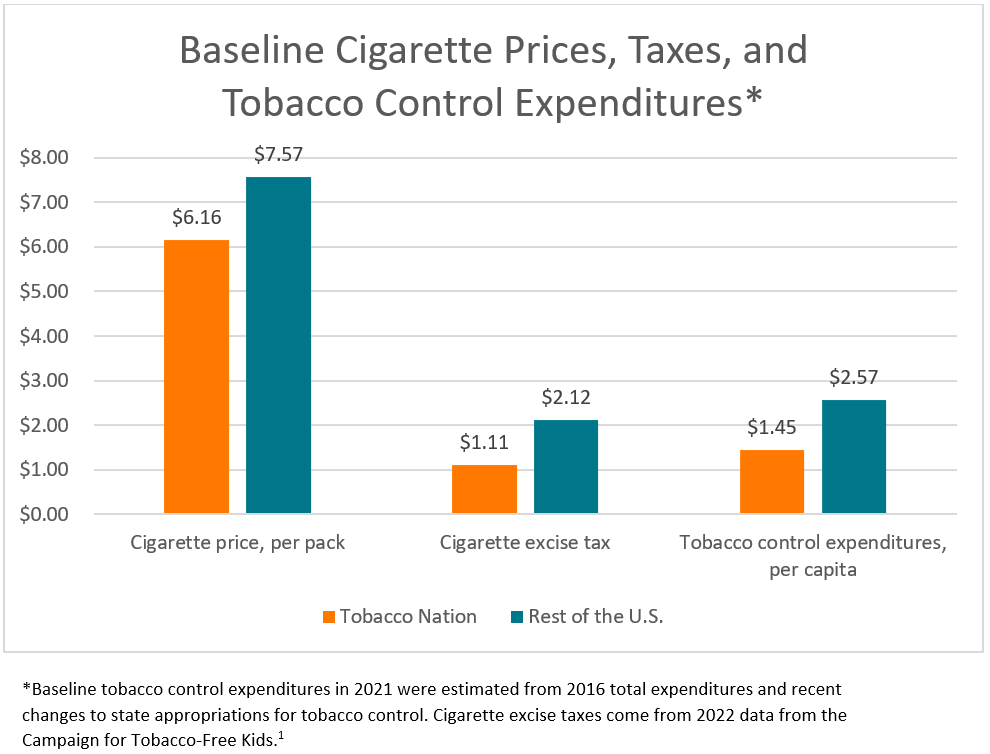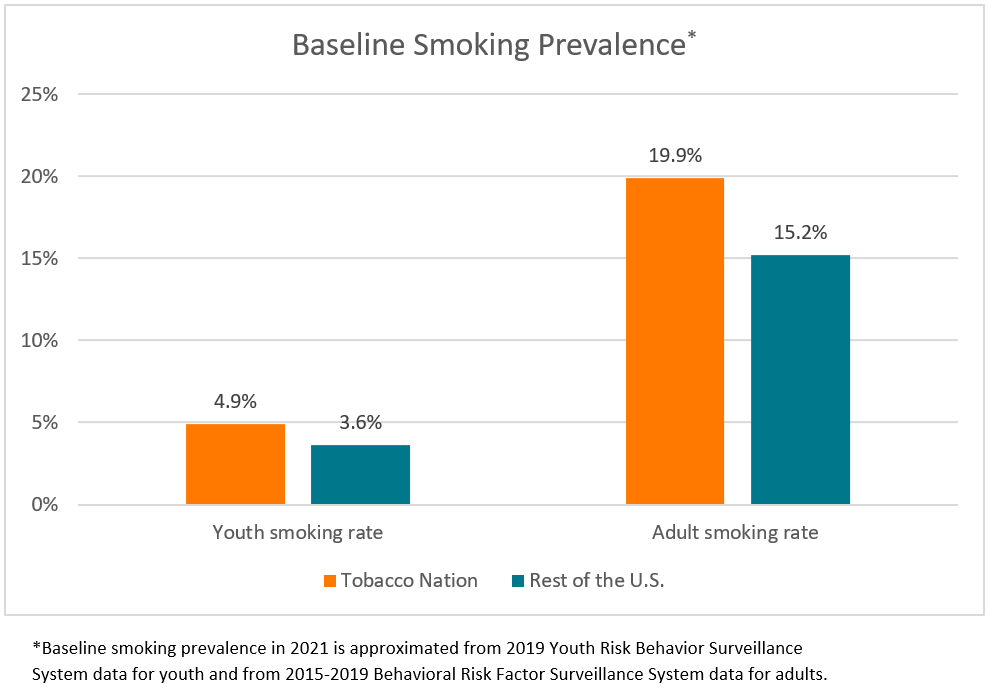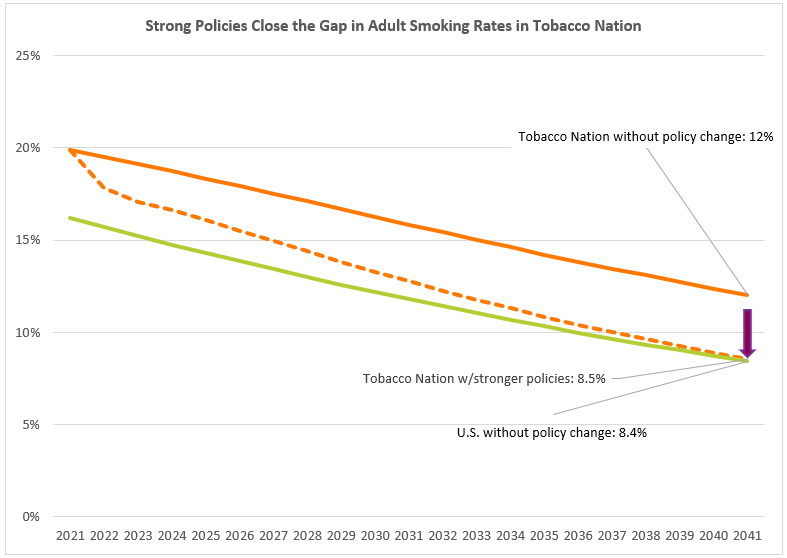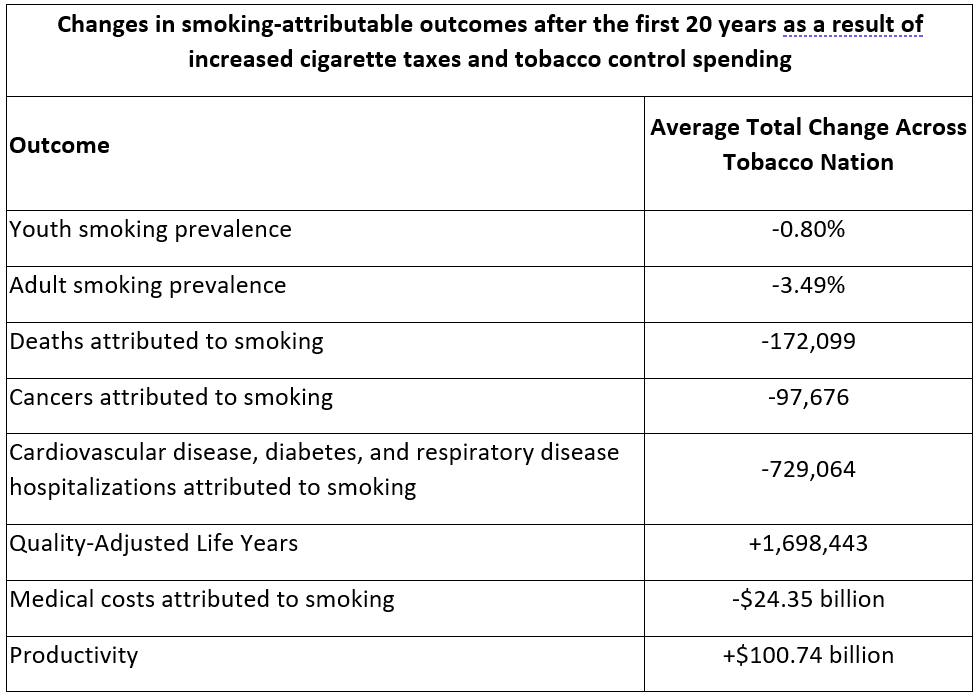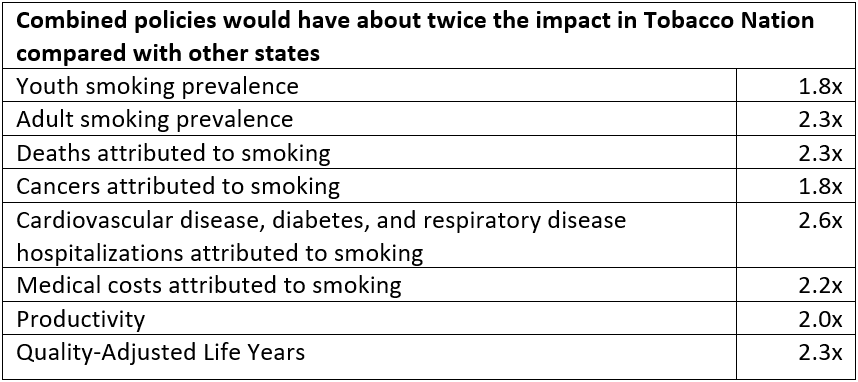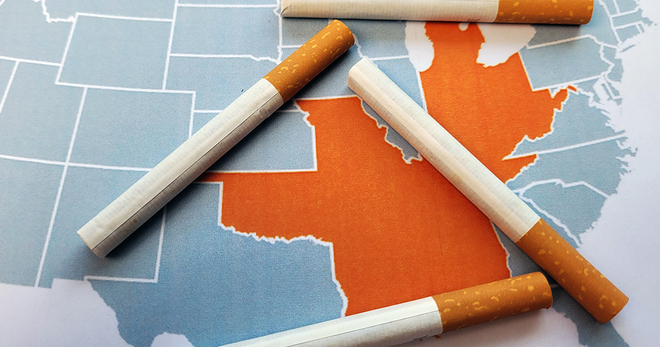
Eliminating smoking disparities in Tobacco Nation
Stronger tobacco control policies in U.S. states with the highest smoking rates could narrow the gap in national adult smoking rates
Increasing spending on tobacco control and raising cigarette taxes in the 13 U.S states with the highest rates of smoking would work to close the gap in adult smoking rates between this region and the rest of the U.S., according to a new analysis by Truth Initiative® and HealthPartners Institute. If implemented, these key tobacco policy changes could also result in substantial health and economic benefits to the region, which we call “Tobacco Nation,” over a 20-year period, including:
- Roughly 100,000 fewer cancer cases, 730,000 fewer hospitalizations, and 170,000 fewer deaths attributed to smoking because of decreased smoking rates.
- Saving over $24 billion in smoking-attributable medical costs and increasing productivity by over $100 billion.
- Among those living below the poverty line, increased cigarette taxes would decrease adverse health outcomes by about five-fold and reduce the adult smoking rate by more than three-fold, compared to changes among those living above the poverty line. Similar trends were seen among non-Hispanic Black populations compared to non-Hispanic White populations in states with the highest smoking rates.

Policy changes would also have about twice the impact on smoking rates and smoking-attributable outcomes compared to other U.S. states. Because states with the highest smoking rates currently spend substantially less on tobacco control programs and have lower cigarette taxes compared to the rest of the nation, policy changes here would have an outsize impact and play a significant role in bringing smoking rates and health outcomes to parity with the U.S. Potential policy impacts, which reach into the billions of dollars and touch hundreds of thousands of lives, speak to the urgent need for state and local governments to advocate for strong local and state tobacco policies, including those that prioritize populations disproportionately impacted by tobacco.
Tobacco Nation
A group of 13 Midwestern and Southern states we call “Tobacco Nation” has persistently higher rates of smoking, higher disease and mortality attributed to smoking, poorer access to health care, and lower income compared to the rest of the U.S.
Tobacco Nation includes Alabama, Arkansas, Indiana, Kentucky, Louisiana, Michigan, Mississippi, Missouri, Ohio, Oklahoma, South Carolina, Tennessee and West Virginia. Read our 2019 report to learn more about Tobacco Nation.
What is Tobacco Nation?
Tobacco control policies are proven to substantially reduce cigarette smoking in the U.S. in the past two decades. However, these policies – which include increased cigarette taxes, community interventions, smokefree air laws, higher tobacco prices, and quitting tobacco interventions – have not been adopted equally across the U.S. states.
This is especially true in Tobacco Nation—a collection of states with large rural communities in the Midwest and South where average smoking rates exceed the rest of the nation for both adults (20% vs. 15%) and youth (4.9% vs. 3.6%). States within Tobacco Nation have less restrictive tobacco control policies compared to much of the nation. For example, in this study we found that cigarette packs at baseline are on average 15% cheaper ($6.16 vs. $7.57) and the excise tax on cigarettes is about half ($1.11 vs. $2.12) in Tobacco Nation states compared to the rest of the U.S. Tobacco Nation states also spend about half as much on tobacco control ($1.45 vs. $2.57 per capita) compared to states not in Tobacco Nation. Spending is lower in Tobacco Nation despite higher recommended levels of spending in this region: recommended tobacco control expenditures at baseline are $13.37 per capita in Tobacco Nation compared to $11.49 per capita in the rest of the U.S. Tobacco control policies lag in Tobacco Nation despite support among residents for strong tobacco control policies.
Increased spending on tobacco control efforts accompanied by raising cigarette taxes can be a powerful combination in reducing smoking rates. Greater tobacco control spending builds better cessation and prevention programs that are critical when higher cigarette taxes ultimately drive people to quit smoking. Funding tobacco control programming and increasing taxes can magnify the public health benefit of raising taxes without also adding to the balance sheet because increased spending can be offset by higher taxes.
Policy changes are the pathway to eliminating disparities
Researchers explored what would happen in Tobacco Nation if tobacco control policies like increasing tobacco control spending and raising cigarette taxes were implemented. Researchers modeled the 20-year impact of increasing cigarette taxes by $1.50 and increasing tobacco control expenditures to levels recommended by the Centers for Disease Control (CDC) for each state on smoking rates and smoking-attributable outcomes – including death, disease, and hospitalizations – in Tobacco Nation.
Although smoking is projected to continue declining nationally over the next 20 years even without policy change, adult smoking rates will remain 42% higher on average in Tobacco Nation states compared to other U.S. states unless we take action.
Increasing tobacco control spending and increasing taxes would have compelling effects in the states with the highest smoking rates, according to the model. Implementing CDC-recommended state tobacco control expenditures and adopting a $1.50 cigarette tax increase in Tobacco Nation would:
- Virtually eliminate adult smoking disparities between Tobacco Nation and the rest of the country. Stronger policies in Tobacco Nation are projected to bring adult smoking rates down to 8.5% in Tobacco Nation states – about where the average adult smoking rate in the U.S. would be without stronger policies, essentially closing the gap between smoking rates in Tobacco Nation and the U.S.
- Dramatically improve smoking-attributable health outcomes. Tobacco Nation states with stronger policies would see roughly 100,000 fewer cancer cases, 730,000 fewer hospitalizations, 170,000 fewer deaths attributed to smoking, as well as gain about 1.7 million quality-adjusted life years – or years of good health – over the next 20 years as a result of decreased smoking rates.
- Create substantial economic benefits. Following tax and spending increases, smoking-attributable medical costs would decrease by more than $24 billion and productivity would increase by over $100 billion in all Tobacco Nation states combined over a 20-year period.
Potential impact of policies on Tobacco Nation is twice that of the rest of the country
Increasing taxes and tobacco control expenditures would reduce smoking-attributable outcomes in all U.S. states, but these stronger policies would have about double the impact in Tobacco Nation compared to other U.S. states, likely because tobacco control expenditures and taxes are substantially lower in Tobacco Nation at baseline. As a result of these policies, adult smoking rates in Tobacco Nation would go down by 3.5%, more than double the 1.5% decrease in adult smoking rates that would be seen if other states adopted the same policies. These policies would also lead to about twice the impact on youth smoking rates, deaths attributed to smoking, and medical costs attributed to smoking in Tobacco Nation compared to other U.S. states.
Impact on youth tobacco use
The model found that higher taxes and greater tobacco control spending also decreased youth use of cigarettes. As a result of these policies, youth cigarette use in Tobacco Nation would decrease by 0.8% compared to a 0.44% decrease in other U.S. states. Impacts of these policies are higher in adult populations because youth smoking rates are lower nationwide. While e-cigarettes are currently the most commonly used tobacco product reported by youth,6 this report did not model impacts of e-cigarettes. While the evidence base is growing, there remain gaps in the research on the long-term harm and impacts of policies governing e-cigarettes.
Higher cigarette taxes have larger impact on Black populations and those living in poverty in Tobacco Nation
Previous research tells us that people respond to cigarette taxes differently, depending on factors like socioeconomic status. According to a report from Community Preventive Services Task Force, low-income individuals show greater decreases in demand for cigarettes after a tax increase compared to high-income populations.7 Given these trends, researchers projected how raising cigarette taxes might affect smoking rates by socioeconomic status and race/ethnicity.
Researchers found that raising the cigarette tax by $1.50 would have a much greater impact on those with incomes lower than 138% of the federal poverty line in Tobacco Nation, compared to those living above 138% of the poverty line. After 20 years of passing a $1.50 cigarette tax increase, among those living in Tobacco Nation below the poverty line:
- Deaths, medical costs, cancers, and hospitalizations due to cardiovascular disease, diabetes, and respiratory diseases attributed to smoking would decrease by about five-fold, compared to changes among those living above the poverty line.
- The adult smoking rate would drop more than three-fold and quality-adjusted life years would more than double, compared to changes among those living above the poverty line.
Similar trends were seen when comparing non-Hispanic Black populations in Tobacco Nation to non-Hispanic White populations. Deaths, medical costs, cancers, and hospitalizations due to cardiovascular disease, diabetes, and respiratory diseases attributed to smoking would decrease about 150% more among non-Hispanic Black Tobacco Nation residents, compared to non-Hispanic White Tobacco Nation residents. These differential health impacts would be seen even though smoking rates for non-Hispanic Black and non-Hispanic White adults would decrease at a similar rate.
Tobacco as a racial justice issue
Tobacco is not an equal opportunity killer. Black Americans and vulnerable populations targeted by the tobacco industry have long faced a disproportionate burden from tobacco-related diseases and death. The tobacco industry strategically and aggressively targeted the Black community for decades, especially with menthol cigarettes. These tactics include placing more advertising in predominantly Black neighborhoods and in publications that are popular with Black audiences, as well as appropriating culture in marketing, including sponsoring events such as jazz and hip-hop festivals. It is critical to ensure that tobacco control policies effectively reach Black communities in order to undo generations of damage that tobacco industry tactics have inflicted on health outcomes of this community.
See “Why Tobacco is a Racial Justice Issue” for more details.
A path forward for Tobacco Nation
It is possible to imagine a United States where Tobacco Nation does not exist anymore: more aggressive tobacco control spending paired with higher taxes targeted to areas with the highest smoking rates can effectively erase disparities in tobacco use that have existed for decades across state borders, resulting in considerable health and economic benefits. Policy changes will be necessary to address this disparity and close the gap between adult smoking rates in Tobacco Nation compared to the overall U.S. smoking rate.
While all states can make substantial gains by increasing cigarette taxes and tobacco control expenditures, the predicted impact in Tobacco Nation states is approximately twice that of other states. Taken together, these findings underscore the unique benefits of prioritizing tobacco control efforts in Tobacco Nation states. Prioritizing tobacco control polices in these states will also greatly benefit populations living in poverty as well as Black Americans who have been targeted by the tobacco industry for decades, use tobacco at disproportionate rates, and are disproportionately affected by tobacco-related death and disease.
Our research shows that erasing tobacco-related health and economic disparities between our states is possible. Here are the evidence-based steps we can take to turn possibility into reality:
- Increase tobacco control spending. Investment in tobacco control remains one of the most efficient public health interventions for saving and improving lives. Increasing spending on tobacco control can provide support to people who make quit-smoking attempts. The significant decline in smoking rates in the U.S. has given the impression that tobacco use isn’t a problem anymore, and funding for tobacco control has accordingly lost urgency. Our findings show that increased tobacco control spending can make a significant difference in saving lives and improving health and economic outcomes, particularly in Tobacco Nation.
- Raise taxes. The research is clear: increases in cigarette taxes can have profound effects on cigarette use, particularly in areas where tobacco use is high. Increased cigarette tax revenue can be directed towards tobacco control efforts to further magnify impact and offset increased spending in this area.
- Focus policies on populations disproportionately impacted by tobacco. Increased taxes have a much greater impact on groups that have been historically targeted by the tobacco industry, such as Black Americans and among those living in poverty. Policymakers should ensure that tobacco control policies reach groups that have been pursued by tobacco industry marketing for generations and have the highest tobacco use rates.
- Strengthen local tobacco control policies. There is an urgent need to remove language in state laws that prevents local adoption of tobacco control policies, something that is historically supported by the tobacco industry. The local level is often where strong and innovative tobacco control policies emerge and are effective in reducing geographic smoking-attributable disparities and should not be undercut by weaker state-wide policies.
- Implement other tobacco control policies. Indoor smoking restrictions, flavored tobacco sales restrictions, and tobacco marketing restrictions can work in tandem with higher taxes and more tobacco control spending to reduce smoking in Tobacco Nation.
This project was a collaboration between Truth Initiative, HealthPartners Institute, and the Robert Wood Johnson Foundation.
More in smoking by region
Want support quitting? Join EX Program
By clicking JOIN, you agree to the Terms, Text Message Terms and Privacy Policy.
Msg&Data rates may apply; msgs are automated.
